Bixa
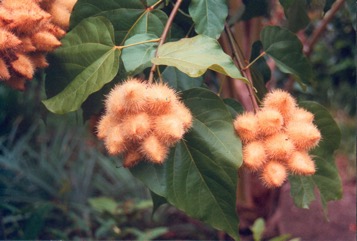
A tropical plant. It suits hot humid tropical and subtropical climates. It needs a temperature above 16-18°C. It is drought and frost tender. It should be grown in full sunlight. It needs a fertile well drained soil. Seed need soil temperatures of at least 19-24°C to start growing. In Papua New Guinea it grows from sea level up to about 2,000 m altitude. It suits hardiness zones 10-12. Bontoc. In XTBG Yunnan.
Also known as:
Achiote, Achote, Achuete, Annato Tree, Arnatto, Atsuete, Axiote, Bija, Conok sayau, Dieu nhuom, Djambarana, Djanfarana, Galuga, Hpawng-long-awn, Japhara, Kam tai, Kari, Kesum, Kesumba, Koeswe, Kum-saet, Kunyit jawa, Latkan, Latkhan, Latpan, Lipstick tree, Lotkon, Maxe, Nteke, Perdu kesumba, Po-thidin, Raktabeja, Rangmale, Rocou, Rocouyer, Roucou, Sendri, Siemphung, Sinduria, Thidin, Tomati-enshee, Tu-hpawng, Urucu, Urucum, Uruku, Vahinamalona, Waiang, Zanzolo-leh
Synonyms
- Biza acuminata Bojer
- Bixa americana Poir.
- Bixa katangensis Delpierre
- Bixa odorata Ruiz & Pav. ex G. Don
- Bixa orellana Bedd.
- Bixa purpurea Sweet
- Bixa tinctaria Salisb.
- Bixa upatensis Ram Goyena
- Bixa urucurana Willd.
- ?
Edible Portion
- Seeds, Spice
Where does Bixa grow?
Found in: Africa, Amazon, Andamans, Argentina, Asia, Australia, Bangladesh, Bolivia, Brazil, Burkina Faso, Cameroon, Caribbean, Central Africa, Central America, China, Colombia, Congo DR, Costa Rica, Côte d'Ivoire, Cuba, Dominican Republic, East Africa, East Timor, Ecuador, Fiji, Galapagos, Ghana, Grenada, Guadeloupe, Guam, Guatemala, Guiana, Guianas, Guinea, Guinée, Guinea-Bissau, Guyana, Haiti, Hawaii, Himalayas, Honduras, India, Indochina, Indonesia, Ivory Coast, Jamaica, Laos, Liberia, Madagascar, Malawi, Malaysia, Marianas, Marquesas, Mexico, Micronesia, Mozambique, Myanmar, Nepal, New Caledonia, Nicaragua, Nigeria, North America, Pacific, Palau, Panama, Papua New Guinea, PNG, Paraguay, Peru, Philippines, Puerto Rico, Rotuma, Sao Tome and Principe, SE Asia, Sierra Leone, South America, Sri Lanka, St Lucia, Suriname, Taiwan, Tanzania, Thailand, Timor-Leste, Togo, Vanuatu, Vietnam, Wallis and Futuna, West Africa, West Indies, Zambia, Zimbabwe
Notes: The plant is often used for face and body painting. There is only one Bixa species. It has anticancer and antioxidant properties.
Status: It is not known if it is used for food in Papua New Guinea.
Growing Bixa
Cultivation: Plants can be grown from seed or cuttings. Semi-ripe cuttings are used.
Edible Uses: The seeds are fried gently and used as a food colouring. It colours butter, margarine, cheese, chocolate. It is ground and used as a spice (Annatto) in South America.
Production: It flowers and fruits throughout the year in Papua New Guinea. Plants grown from cuttings tend to flower at a younger age.
Nutrition Info
per 100g edible portion| Edible Part | Energy (kcal) | Protein (g) | Iron (mg) | Vitamin A (ug) | Vitamin c (mg) | Zinc (mg) | % Water |
|---|---|---|---|---|---|---|---|
| Seeds - flavour | - | - | - | - | - | - |
Bixa Photos

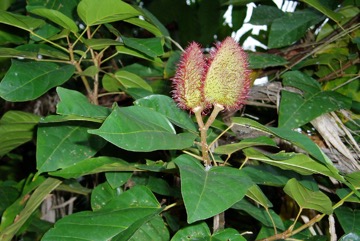
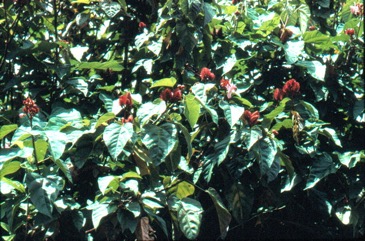
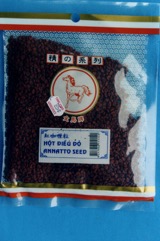
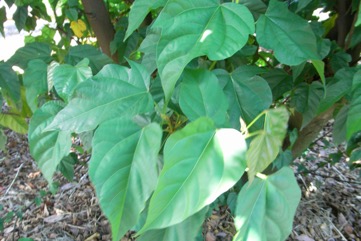
References
Ambasta S.P. (Ed.), 2000, The Useful Plants of India. CSIR India. p 74
Arellanes, Y., et al, 2013, Influence of traditional markets on plant management in the Tehuacan Valley. Journal of Ethnobiology and Ethnomedicine 9:38
Barwick, M., 2004, Tropical and Subtropical Trees. A Worldwide Encyclopedic Guide. Thames and Hudson p 52
Bennett, B. C., 1990, Useful Plants of Amazonian Ecuador. US Agency for International Development. Fifth Progress Report. New York Botanical Gardens. p 40
Bodkin, F., 1991, Encyclopedia Botanica. Cornstalk publishing, p 149
Bodner, C. C. and Gereau, R. E., 1988, A Contribution to Bontoc Ethnobotany. Economic Botany, 43(2): 307-369
Borrell, O.W., 1989, An Annotated Checklist of the Flora of Kairiru Island, New Guinea. Marcellin College, Victoria Australia. p 59
Bremness, L., 1994, Herbs. Collins Eyewitness Handbooks. Harper Collins. p 41
Brickell, C. (Ed.), 1999, The Royal Horticultural Society A-Z Encyclopedia of Garden Plants. Convent Garden Books. p 180
Brouk, B., 1975, Plants Consumed by Man. Academic Press, London. p 266
Brown, D., 2002, The Royal Horticultural Society encyclopedia of Herbs and their uses. DK Books. p 144
Burkill, I.H., 1966, A Dictionary of the Economic Products of the Malay Peninsula. Ministry of Agriculture and Cooperatives, Kuala Lumpur, Malaysia. Vol 1 (A-H) p 333
Cabalion, P. and Morat, P., 1983, Introduction le vegetation, la flore et aux noms vernaculaires de l'ile de Pentcoste (Vanuatu), In: Journal d'agriculture traditionnelle et de botanique appliquee JATBA Vol. 30, 3-4
Condit, R., et al, 2011, Trees of Panama and Costa Rica. Princeton Field Guides. p 94
Coe, F. G., and Anderson, G. J., 1996, Ethnobotany of the Garifuna of Eastern Nicaragua. Economic Botany 50(1) pp 71-107
Coe, F. G. and Anderson, G. J., 1999, Ethnobotany of the Sumu (Ulwa) of Southeastern Nicaragua and Comparisons with Miskitu Plant Lore. Economic Botany Vol. 53. No. 4. pp. 363-386
Croft, J., in Henty, E. E., (Ed.), 1981, Handbooks of the Flora of Papua New Guinea, Melbourne University Press, p 1
Cundall, P., (ed.), 2004, Gardening Australia: flora: the gardener's bible. ABC Books. p 239
Duchelle, A. E., 2007, Observations on Natural Resource use and Conservation by the Shuar In Ecuador's Cordillera del Condor. Ethnobotany Research & Applications 5:005-023
Engel, D.H., & Phummai, S., 2000, A Field Guide to Tropical Plants of Asia. Timber Press. p 36
Etherington, K., & Imwold, D., (Eds), 2001, Botanica's Trees & Shrubs. The illustrated A-Z of over 8500 trees and shrubs. Random House, Australia. p 133
Facciola, S., 1998, Cornucopia 2: a Source Book of Edible Plants. Kampong Publications, p 50
Flora of Australia, Volume 8, Lecythidales to Batales, Australian Government Publishing Service, Canberra (1982) p 85
Forest Inventory and Planning Institute, 1996, Vietnam Forest Trees. Agriculture Publishing House p 74
Fowler, D. G., 2007, Zambian Plants: Their Vernacular Names and Uses. Kew. p 23
Glew, R. H., et al, 1997, Amino Acid, Fatty Avid and Mineral Composition of 24 Indigenous Plants of Burkina Faso. Journal of Food Composition and Analysis 10, 205-217
Grandtner, M. M. & Chevrette, J., 2013, Dictionary of Trees, Volume 2: South America: Nomenclature, Taxonomy and Ecology. Academic Press p 65
Guatemala thesis 19 - AppendixE
Hawthorne, W.& Marshall, C., 2013, Nimba Western Area Iron Ore Concentrator Mining Project Environmental and Social Impact Assessment. AcelorMittel Liberia. p 461
Hearne, D.A., & Rance, S.J., 1975, Trees for Darwin and Northern Australia. AGPS, Canberra p 32
Hedrick, U.P., 1919, (Ed.), Sturtevant's edible plants of the world. p 107
Heywood, V.H., Brummitt, R.K., Culham, A., and Seberg, O. 2007, Flowering Plant Families of the World. Royal Botanical Gardens, Kew. p 64
Hunter, D., et al, 2019, The potential of neglected and underutilized species for improving diets and nutrition. Planta (2019) 250:709-729
Hutton, W., 1997, Tropical Herbs and Spices of Indonesia. Periplus. p 10
Jansen, P.C.M., 2005. Bixa orellana L. [Internet] Record from Protabase. Jansen, P.C.M. & Cardon, D. (Editors). PROTA (Plant Resources of Tropical Africa / Ressources végétales de l’Afrique tropicale), Wageningen, Netherlands. < http://database.prota.org/search.htm>. Accessed 14 October 2009.
Kiple, K.F. & Ornelas, K.C., (eds), 2000, The Cambridge World History of Food. CUP p 1719
Krishen P., 2006, Trees of Delhi, A Field Guide. DK Books. p 112
Latham, P., 2004, Useful Plants of Bas-Congo province. Latham & DFID p 51
Latham, P. & Mbuta, A. K., 2014, Useful Plants of Bas-Congo Province, Democratic Republic of Congo. Volume 1. Salvation Army. p 77
Lazarides, M. & Hince, B., 1993, Handbook of Economic Plants of Australia, CSIRO. p 33
Lentz, D. L., 1993, Medicinal and Other Economic Plants of the Paya of Honduras. Economic Botany, Vol. 47, No. 4, pp. 358-370
Llamas, K.A., 2003, Tropical Flowering Plants. Timber Press. p 147
Lord, E.E., & Willis, J.H., 1999, Shrubs and Trees for Australian gardens. Lothian. p 49
Lorenzi, H., 2002, Brazilian Trees. A Guide to the Identification and Cultivation of Brazilian Native Trees. Vol. 01 Nova Odessa, SP, Instituto Plantarum p 74
Manandhar, N.P., 2002, Plants and People of Nepal. Timber Press. Portland, Oregon. p 113
McMakin, P.D., 2000, Flowering Plants of Thailand. A Field Guide. White Lotus. p 11
Menninger, E.A., 1977, Edible Nuts of the World. Horticultural Books. Florida p 115
Montani, M. C. & Scarpa, G. F., 2016, Recursos vegetales y prácticas alimentarias entre indígenas tapiete del noreste de la provincia de Salta, Argentina. Darwiniana, nueva serie vol.4 no.1 San Isidro jul. 2016
Morley, B.D., & Toelken, H.R., (Eds), 1983, Flowering Plants in Australia. Rigby. p 94
Oliviera V. B., et al, 2012, Native foods from Brazilian biodiversity as a source of bioactive compounds. Food Research International 48 (2012) 170-179
Omawale, 1973, Guyana's edible plants. Guyana University, Georgetown p 63
Paz, F. S., et al, 2021, Edible Fruit Plant Species in the Amazon Forest Rely Mostly on Bees and Beetles as Pollinators. Journal of Economic Entomology, XX(XX), 2021, 1–13
Peekel, P.G., 1984, (Translation E.E.Henty), Flora of the Bismarck Archipelago for Naturalists, Division of Botany, Lae, PNG. p 381, 380
Perry, F., and Hay, R., 1982, Guide to Tropical and Subtropical Plants. Sun Books p 14
Pham-Hoang Ho, 1999, An Illustrated Flora of Vietnam. Nha Xuat Ban Tre. p 547
Plants of Haiti Smithsonian Institute http://botany.si.edu
Purseglove, J.W., 1968, Tropical Crops Dicotyledons, Longmans. p 629
Raghavan, S., 2007, Handbook of Spices, Seasonings, and Flavourings. Second Edition. CRC Press p 68
Rahmatullah, M., et al, 2009, A survey of medicinal plants in two areas of Dinajpur district, Bangladesh including plants which can be used as functional foods. American-Eurasian Journal of Sustainable Agriculture, 3(4): 862-876
Segura, S. et al, 2018, The edible fruit species in Mexico. Genet Resour Crop Evol (2018) 65:1767–1793
Seidemann J., 2005, World Spice Plants. Economic Usage, Botany, Taxonomy. Springer. p 65
Smith, N., Mori, S.A., et al, 2004, Flowering Plants of the Neotropics. Princeton. p 54
Solomon, C., 2001, Encyclopedia of Asian Food. New Holland. p 11
Sp. pl. 1:512. 1753
Steggerda, M., Some Ethnological Data Concerning One Hundred Yucatan Plants. Smithsonian Institution Anthropological Papers, No. 29
Sukarya, D. G., (Ed.) 2013, 3,500 Plant Species of the Botanic Gardens of Indonesia. LIPI p 592
Swaminathan, M.S., and Kochnar, S.L., 2007, An Atlas of Major Flowering Trees in India. Macmillan. p 29
Vael, L., 2015, Ethnobotanical study of the plant use in the natural landscape of two mestizo communities in the Ucayali region of the Peruvian Amazon. Universiteit Gent.
van Roosmalen, M.G.M., 1985, Fruits of the Guianan Flora. Utrecht Univ. & Wageningen Univ. p 54
van Wyk, B., 2005, Food Plants of the World. An illustrated guide. Timber press. p 90
Vasquez, R. and Gentry, A. H., 1989, Use and Misuse of Forest-harvested Fruits in the Iquitos Area. Conservation Biology 3(4): 350f
Vickery, M.L. and Vickery, B., 1979, Plant Products of Tropical Africa, Macmillan. p 101
Williams, C.N., Chew, W.Y., and Rajaratnam, J.A., 1989, Tree and Field Crops of the Wetter Regions of the Tropics. Longman, p 222
Williamson, J., 2005, Useful Plants of Malawi. 3rd. Edition. Mdadzi Book Trust. p 37
Woodward, P., 2000, Asian Herbs and Vegetables. Hyland House. p 33
World Checklist of Useful Plant Species 2020. Royal Botanic Gardens, Kew
www.colecionandofrutas.org
www.worldagroforestrycentre.org/treedb/
Young, J., (Ed.), 2001, Botanica's Pocket Trees and Shrubs. Random House. p 141
Zaldivar, M. E., et al, 2002, Species Diversity of Edible Plants Grown in Homegardens of Chibehan Amerindians from Costa Rica. Human Ecology, Vol. 30, No. 3, pp. 301-316